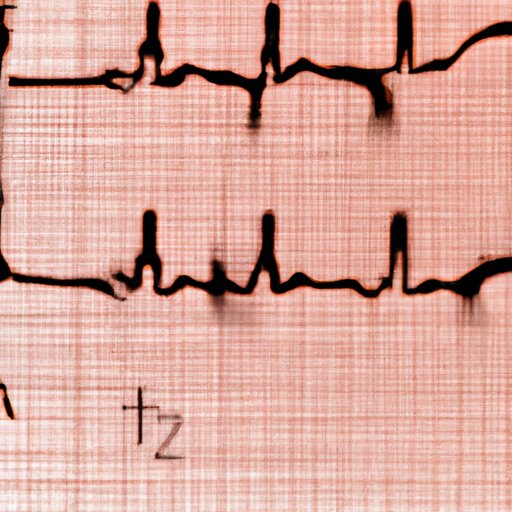
Introduction
Heart disease is one of the leading causes of death worldwide. According to the World Health Organization, an estimated 17.9 million people die each year from heart disease. Early detection of heart disease is crucial to prevent further complications. That’s why heart disease testing plays a significant role in identifying potential problems and implementing preventive measures. In this comprehensive guide, we will explore the different tests for heart disease and how they work.
A Comprehensive Guide to the Different Tests for Heart Disease
There are several tests that doctors use to detect heart disease. Here are some of the most common ones:
Electrocardiogram (ECG or EKG)
An electrocardiogram (ECG or EKG) is a non-invasive test that records the electrical activity of the heart. The test measures the heart’s rhythm, rate, and timing of electrical impulses. This test is done by attaching electrodes to the chest, arms, and legs. An ECG can help detect heart arrhythmias, a potential sign of heart disease.
Echocardiogram
An echocardiogram is a non-invasive test that uses sound waves to create images of the heart. It provides information on the size and shape of the heart, the thickness and movement of its walls, and the functioning of the valves. An echocardiogram can help diagnose conditions such as heart failure, valve disease, and congenital heart defects.
Stress test
A stress test, also known as an exercise stress test, helps examine how your heart responds to physical activity. The test is done by walking on a treadmill or riding a stationary bike with electrodes attached to your chest. This test can help diagnose coronary artery disease, which occurs when there’s a buildup of plaque in the coronary arteries.
Coronary Angiography
A coronary angiography is an invasive test that uses X-rays and dye to examine the coronary arteries. The test helps detect any blockages or narrowing in the arteries. During the test, a thin tube called a catheter is inserted into an artery in your groin or arm and threaded through to your heart. The dye is then injected to help visualize the arteries. This test is typically done if there is an abnormal result found from previous tests such as an EKG.
Computed Tomography (CT) Scan
A CT scan uses X-rays and computer technology to produce detailed images of the heart and blood vessels. The test is done by lying on a table that slides into a machine that takes the images. The test helps detect calcium buildup in the arteries which is a major indicator for heart disease.
Magnetic Resonance Imaging (MRI)
An MRI uses strong magnets and radio waves to create detailed images of the heart and blood vessels. This test is useful in detecting heart disease that cannot be detected with other tests, such as congenital heart defects. It can help identify problems with the heart muscle, valves, and blood vessels.
Blood Tests
Blood tests can provide a lot of valuable information about heart disease. A lipid panel measures the cholesterol levels in the blood, while a high-sensitivity C-reactive protein (hs-CRP) test measures inflammation in the body. Elevated levels of hs-CRP can indicate a higher risk of heart disease. Other blood tests can also measure the levels of enzymes and proteins that indicate heart muscle damage.
Holter Monitor
A Holter monitor is a small, wearable device that records the heart’s electrical activity over 24 to 48 hours. This test is useful in identifying heart arrhythmias and provides more detailed information than an ECG.
How to Know If You’re at Risk for Heart Disease and Which Test to Choose
Various factors could lead to heart disease. These include age, sex, family history, high blood pressure, high cholesterol, obesity, smoking, diabetes, and a sedentary lifestyle.
To assess your risk for heart disease, your doctor will likely perform a physical exam, gather your medical history, and order tests. Based on your risk factors, the doctor will determine which specific tests to administer. For example, if you have high cholesterol levels, your doctor may order a lipid panel.
Early Detection Is Key: Heart Disease Testing for Prevention
Testing for heart disease is essential to prevent the condition from worsening. Early detection can help detect a problem at its earliest stage and allow for prevention before irreversible damage occurs. A regular check-up with a doctor and cardiac tests should be a part of routine healthcare maintenance.

A Breakdown of the Basic Tests for Heart Disease
Electrocardiogram (ECG or EKG)
The ECG is painless, non-invasive and the test is frequently performed to evaluate the heart’s rhythm, rate, and electrical activity. It measures the electrical signals generated by the heart, providing insight into any potential arrhythmias that could lead to heart disease.
Echocardiogram
An echocardiogram does not involve any direct contact with the heart. It uses sound waves to provide detailed images of the heart to examine heart function and structure.
Stress Test
A stress test is performed on a treadmill or bicycle under the supervision of a trained medical professional. It helps evaluate the heart’s responses to different levels of physical activity.
How the Latest Technology is Changing Heart Disease Testing
The medical field of cardiology has many advancements. Recent advancements have drastically improved testing for heart disease. A prime example of such an improvement is artificial intelligence (AI) systems that recognize heart disease patterns more effectively and accurately than a cardiologist. Additionally, a new test called Cardiogoniometry provides an alternative non-invasive method of detecting heart disease blockages.
What to Expect from a Heart Disease Stress Test
Before having a stress test, there are a few things you will need to do to prepare. Wear comfortable clothes and shoes and avoid eating or drinking anything except water for at least four hours before the test. The test will involve walking on a treadmill or cycling on a stationary bike while your heart rate and blood pressure are monitored. The test will progressively increase in intensity. After the test is completed, you will be monitored for a short time to ensure your heart has returned to its normal level.
The Importance of Regular Heart Health Checkups
While heart disease testing is vital, so is ensuring that your heart is in good shape regularly. By having regular check-ups with a doctor, you can work together to assess the overall health of your heart and discuss any concerns and lifestyle modifications.
Conclusion
Heart disease testing is necessary to prevent potential complications. With early detection, people with heart disease can prevent their condition from worsening. From blood tests to stress tests, there is a wide range of cardiac testing available. Knowing which tests are most appropriate for you might require a visit to your doctor, but in the end, it’s essential for prevention and maintaining a healthy heart.





